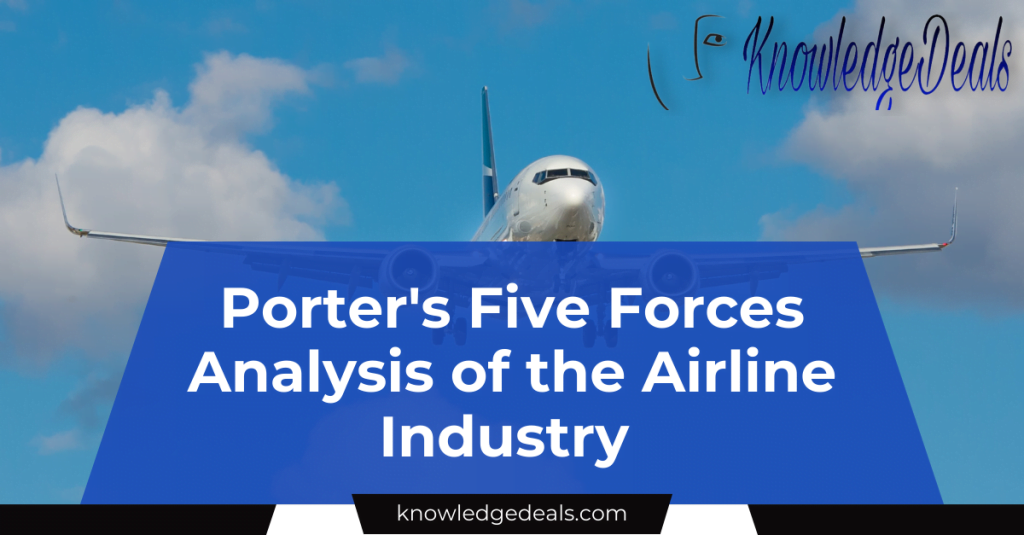[ad_1]
Welcome to our article discussing the Porter’s Five Forces Analysis of the Airline Industry. In this article, we will explore the five forces that shape the competitive environment in the airline industry and how these forces impact the industry’s profitability and attractiveness. We will also provide insights into how airlines can use this analysis to develop effective strategies to navigate the challenges and opportunities in the market.
What are Porter’s Five Forces?
Porter’s Five Forces is a framework developed by Michael Porter that helps businesses analyze the competitive forces in an industry and determine the attractiveness of the industry. The five forces include the threat of new entrants, the bargaining power of buyers, the bargaining power of suppliers, the threat of substitute products or services, and the intensity of competitive rivalry.
When applied to the airline industry, these forces can provide valuable insights into the industry’s dynamics and competitive landscape.
How does the Threat of New Entrants Impact the Airline Industry?
The threat of new entrants refers to the likelihood of new competitors entering the market and disrupting the existing competitive landscape. In the airline industry, the barriers to entry are high, with significant capital requirements for purchasing aircraft, establishing routes, and obtaining necessary permits and licenses. Additionally, established airlines benefit from economies of scale, brand recognition, and loyalty programs, making it difficult for new entrants to gain a foothold in the market.
However, the emergence of low-cost carriers has lowered the barriers to entry in some segments of the market, leading to increased competition and price pressure. As a result, established airlines need to continually innovate and differentiate their offerings to maintain their competitive advantage.
What is the Bargaining Power of Buyers in the Airline Industry?
Buyers in the airline industry, including individual passengers and corporate customers, have significant bargaining power due to the availability of information, price transparency, and the proliferation of online booking platforms. Additionally, the low switching costs for passengers and the commoditization of air travel further increase their bargaining power.
This dynamic has led to intense price competition and challenges in maintaining customer loyalty. Airlines need to focus on providing value-added services, enhancing the customer experience, and building strong brand relationships to mitigate the impact of buyer bargaining power.
How does the Bargaining Power of Suppliers Affect the Airline Industry?
In the airline industry, suppliers such as aircraft manufacturers, fuel suppliers, and maintenance providers have varying degrees of bargaining power. For example, there are a limited number of aircraft manufacturers, leading to significant bargaining power in negotiating aircraft purchase and maintenance contracts.
Similarly, the volatility of fuel prices and the reliance on a small number of fuel suppliers can impact airline operating costs and profitability. As a result, airlines need to carefully manage supplier relationships, hedging strategies, and operational efficiency to mitigate the impact of supplier bargaining power.
What is the Threat of Substitute Products or Services in the Airline Industry?
The threat of substitute products or services in the airline industry stems from alternative modes of transportation, such as rail, road, and sea travel, as well as advancements in teleconferencing and virtual meetings. Additionally, the growing trend of remote work and digital nomadism has impacted travel patterns and demand for air travel.
Airlines need to stay attuned to changing consumer preferences, technological advancements, and macroeconomic trends to identify and address the threat of substitutes. Offering unique value propositions, enhancing convenience, and leveraging digital technologies can help airlines mitigate the threat of substitutes and maintain their competitive position.
How does the Intensity of Competitive Rivalry Impact the Airline Industry?
The airline industry is characterized by intense competitive rivalry, with numerous airlines vying for market share, routes, and passenger demand. Price competition, capacity fluctuations, and the battle for customer loyalty contribute to the high intensity of competitive rivalry in the industry.
To navigate this competitive landscape, airlines need to focus on differentiation, operational efficiency, route optimization, and strategic alliances to carve out a sustainable competitive advantage. Collaborations, code-sharing agreements, and network optimization can help airlines expand their reach and enhance their value proposition amidst intense rivalry.
Conclusion
Porter’s Five Forces Analysis offers a comprehensive framework for assessing the competitive dynamics of the airline industry. By understanding the forces at play and their impact on industry profitability, airlines can develop informed strategies to navigate challenges, capitalize on opportunities, and sustain their competitive advantage.
FAQs
1. What are the key takeaways from Porter’s Five Forces Analysis in the airline industry?
The key takeaways from Porter’s Five Forces Analysis in the airline industry include the importance of assessing the threat of new entrants, the bargaining power of buyers and suppliers, the threat of substitutes, and the intensity of competitive rivalry. By understanding these forces, airlines can develop effective strategies to withstand competition and drive profitability.
2. How can airlines mitigate the impact of buyer bargaining power?
Airlines can mitigate the impact of buyer bargaining power by focusing on value-added services, enhancing the customer experience, and building strong brand relationships. By providing differentiated value propositions and fostering customer loyalty, airlines can reduce the likelihood of customers switching to competitors solely based on price.
3. What strategies can airlines employ to address the threat of substitute products or services?
To address the threat of substitute products or services, airlines can focus on offering unique value propositions, enhancing convenience, and leveraging digital technologies to improve the overall travel experience. By staying attuned to changing consumer preferences and technological advancements, airlines can identify and capitalize on opportunities to differentiate their offerings from substitutes.
4. How does the intensity of competitive rivalry influence airline strategies?
The intensity of competitive rivalry in the airline industry necessitates a focus on differentiation, operational efficiency, route optimization, and strategic alliances. By collaborating with other airlines, optimizing routes, and enhancing operational efficiency, airlines can withstand price competition and solidify their position in the market.
5. What are the implications of Porter’s Five Forces Analysis for airline industry profitability?
Porter’s Five Forces Analysis provides insights into the factors that impact airline industry profitability, such as the balance of power between industry players, competitive dynamics, and the threat of substitutes. By understanding these implications, airlines can make informed decisions to enhance profitability and sustain their competitive advantage.
[ad_2]





